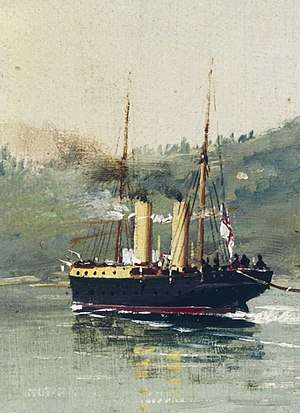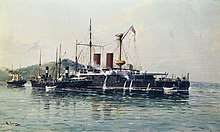HMS Seahorse (1880)
HMS Seahorse was a Royal Navy fleet tug, tender and survey ship built in 1880. She served until the end of the First World War and was subsequently sold for commercial service in Spain.
 HMS Seahorse | |
| History | |
|---|---|
| Name: | HMS Seahorse (pennant W.72 from 1918) |
| Namesake: | seahorse |
| Builder: | Laird Brothers[2] |
| Yard number: | 471[3] |
| Launched: | 7 July 1880[3] |
| Commissioned: | 20 January 1881[4] |
| Status: | Sold 1 May 1920 to Crichton Thompson[2] |
| History | |
| Name: | Chita |
| Namesake: | cheetah |
| Owner: |
|
| Fate: | Broken up in 1933 |
| General characteristics | |
| Displacement: | 670 tons |
| Length: | 160 ft pp, 168 feet overall |
| Beam: | 26 ft |
| Draught: | 10 ft |
| Speed: | 12.5 knots[2] |
| Complement: | 84[5] |
| Armament: | One 12 pounder[2][5] or two six pounder[2][4] |
Description
HMS Seahorse was designed and built by Laird Brothers at Birkenhead[note 1] for the Royal Navy as a fast deep-sea tug, suitable for handling their new classes of ironclad warship. In addition she was equipped for deployment as a fleet tender and despatch vessel.[7] Steel was used in both the engines and shafts and, in the form of Siemens-Martin steel from the Landore Steel Company, for the hull and upperworks.[7][8][note 2] Seahorse's displacement was 670 tons, and dimensions 160 ft (48.8 m) length between perpendiculars, 168 ft (51.2 m) length overall, 26 ft (7.9 m) beam and with 10 ft (3.0 m) draught. She was powered by a pair of compound steam engines totalling 1100 ihp driving twin screws.[7]

Service history
Based at Portsmouth, as well as a fleet tug, Seahorse served in a variety of roles, including survey ship,[9] and was often described as a gunboat or "special service vessel".[10][11] During the Anglo-Egyptian War of 1882 Seahorse was additionally equipped with gatling guns and stationed at Port Said for towing and patrol duties in the Suez Canal.[12][13] Amongst her salvage jobs was the battleship HMS Howe, which stranded on a shoal off Ferrol, Spain in November 1892 and could be refloated only five months later.[14] During the First World War she continued to be based at Portsmouth where she was used as a fleet tug, and later a rescue tug.
Commercial service
On 1 May 1920 Seahorse was disposed of by the Admiralty to Crichton Thompson & Co Ltd, and resold to Arsenio Sanjurjo Igual of Santander, Spain, where she was renamed Chita. She changed hands twice at Santander, first to Luis Liaño in 1925 and then to Nicolas Pardo y Pardo in 1928. She was finally broken up at Santander in 1933.[3][6]
Notes
References
- Winfield, David Lyon & Rif (2004). The sail & steam Navy list : all the ships of the Royal Navy 1815 - 1889. London: Chatham. p. 284. ISBN 1-86176-032-9.
- "Seahorse". Miramar Ship Index (subscription required). Wellington NZ: R B Haworth. Retrieved 14 January 2020.
- "Seahorse, 1881". P. Benyon Naval Database. Archived from the original on 10 August 2017. Retrieved 30 May 2015.
- "Eng. Capt. Charles T. D. Greetham". Naval Historical Collectors & Research Association. Archived from the original on 31 May 2015. Retrieved 30 May 2015.
- Lloyd's Register of Ships (PDF). Lloyd's Register of Shipping. 1933. p. [141]. Retrieved 14 January 2020.
- "Naval and Military Intelligence". The Times (30044). London. 20 November 1880. p. 5.
- "Visits to Works". Journal of The Iron and Steel Institute. 1879. Retrieved 2 March 2016.
- "Naval and Military Intelligence". The Times (34718). London. 26 October 1895. p. 11.
- "Naval and Military Intelligence". The Times (30366). London. 1 December 1881. p. 6.
- "Naval and Military Intelligence". The Times (30945). London. 8 October 1883. p. 7.
- "Naval and Military Intelligence". The Times (30605). London. 6 September 1882. p. 3.
- "Naval and Military Intelligence". The Times (30611). London. 13 September 1882. p. 3.
- "The Howe". The Times (33913). London. 31 March 1893. p. 7.
See also
The history of tug Chita (in Spanish)